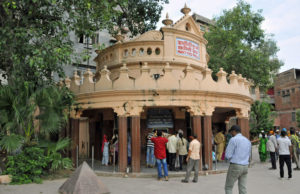
Martyrs’ Well in Amritsar, India (Photo by Don Knebel)
On April 10, 1919, violent protests in Amritsar led British Brigadier General Reginald Dyer to impose a ban on all public gatherings. On April 13, thousands of Sikhs in Amritsar for their annual Baisakhi festival, unaware of the ban, congregated in Jallianwall Bagh, a six-acre public garden near the Golden Temple, where they joined protestors knowingly violating the ban. Seeing the huge gathering as a threat to his ability to maintain order, General Dyer arrived at Jallianwall Bagh with 50 armed troops, who immediately and without warning began firing indiscriminately at the crowd. People tried to run, but their escape routes were blocked by either walls or British forces. Some people were crushed to death as they tried to leave. Others jumped into a large garden well. The soldiers stopped shooting only when they ran short of ammunition. An official inquiry by the House of Commons, which led to the resignation of General Dyer, counted 379 unarmed dead and 1200 wounded, including women and children. Indians have always believed the casualty count must have been much higher because of the large number of people in Jallianwall Bagh when the shooting started.
What became known as the Amritsar Massacre convinced Mohandas Gandhi to initiate the non-violent struggle that eventually led to Indian independence in 1947. In 1951, the Indian government erected a memorial honoring the victims of the massacre inside Jallianwall Bagh, near brick walls still displaying bullet holes. Perhaps the most poignant reminder is the Martyrs’ Well, with a sign saying that 120 bodies were found piled at the bottom.